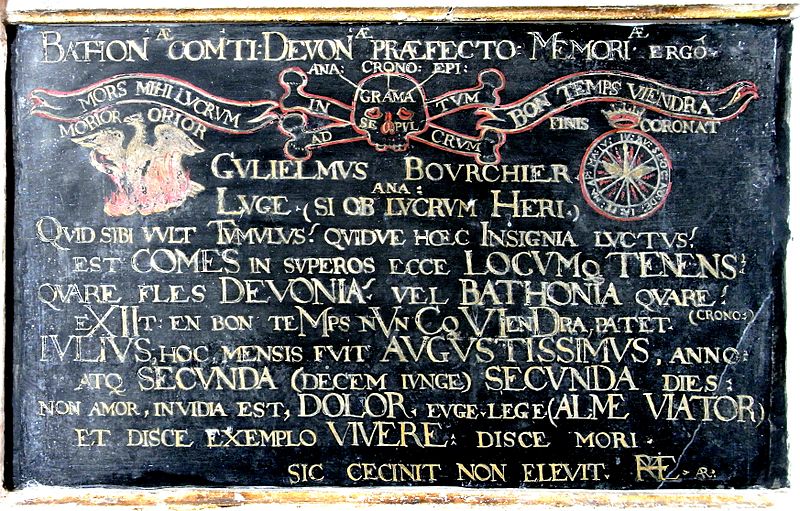Image: BourchierAnagramChronogramEpigram1623TawstockDevon

Description: Inscribed tablet on base of monument to William Bourchier, 3rd Earl of Bath (d.1623), St Peter's Church, Tawstock, Devon. It comprises separate elements of anagram, chronogram and epigram. Top: Bathon(i)ae Com(i)ti Devonae praefecto memoriae ergo ("To the memory of the Earl of Bath therefore to the prefect (i.e. Lord Lieutenant) of Devon"). Beneath this line is in the centre an inscribed skull and crossbones, with to its left the image of a phoenix rising from a fire above which is Morior Orior ("I am dead, I shall arise") above which is inscribed on a scroll the well-known Roman epithet: Mors mihi lucrum ("Death to me is reward"). On the right side of the skull is an image of a circular dial inscribed around the circumference with the first two letters of the 12 months of the year. The top-most month, which is crowned, is IV i.e. JU for July, the month of his death. Above is inscribed: Finis Coronat ("the end crowns"), above which is inscribed on a scroll the French motto of Bourchier: Bon temps viendra ("The right time will come"). Within the skull is written on the top line grama, to which word three other words point from above the skull, ana-, chrono- and epi- (all Greek words in Latin form). These denote to the reader the presence of anagrams, chronograms, epigrams and other puzzles within the tablet. In the skull below the word grama are the two Latin words se and pul, and on the two bones which intersect behind the skull are written 4 more Latin words: ad, in, tum, and crum, which may all be combined together to form the sentences: in sepulcrum ad sepultum ("into the grave in order to be buried") or in sepultum ad se pulcrum ("in the act of burial one's-self (is made) beautiful"). Below is the anagram, on the top line the words Gulielmus Bourchier ("William Bourchier"), below which is the indicator ana-: and the name's Latin anagram Luge (si ob lucrum heri) ("mourn if on account of the profit of yesterday"). Below is a Latin epigram with some words in capitals, which may relate to a chronogram or other word-game: Quid sibi vult tumulus quidve haec insignia luctus est comes in superos ecce locumo tenens quare fles Devonia vel Bathonia quare ("If you wish to know what is this pile or why this great mourning, the Earl behold is above as place-holder (lieutenant), as weeps Devon and Bath"). Below is a chronogram: "eXIIt en bon teMps nVnCo VIenDra patet" (exiit en bon temps nunc (o?) viendra patet) a mixture of limited sense in Latin and the French motto of Bourchier, meaning "he went in good time now he shall come he seeks". When the capital Roman numerals are added together individually they make 1,623, the year of his death. Underneath is a further possibly criptic epigram, with some words in capitals: Julius hoc mensis fuit Augustissimus anno atq(ue) secunda decem junge secunda dies non amor invidia est dolor euge lege alme viator et disce exemplo vivere: disce more sic cecivit (cecidit?) not elevit, translated as "The month of July was the most august in this year and the following day...is hatred not love, well-done! read O Traveller and teach by (his) example (how ) to live: teach (how) to die, thus he has falled he has not arisen". At the end are two monograms: "R...E" and "AR".
Title: BourchierAnagramChronogramEpigram1623TawstockDevon
Credit: Self-photographed
Author: (Lobsterthermidor (talk) 18:13, 26 March 2013 (UTC))
Usage Terms: Public domain
License: Public domain
Attribution Required?: No
Image usage
The following page links to this image:

